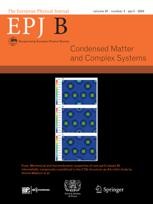Determining the shapes of atomic clusters
By considering the crystal structures of atomic clusters in new ways, researchers may be able to better assess whether the groups have distinctive shapes, or whether they are amorphous.
New York | Heidelberg, 24 October 2019
 Too large to be classed as molecules, but too small to be bulk solids, atomic clusters can range in size from a few dozen to several hundred atoms. The structures can be used for a diverse range of applications, which requires a detailed knowledge of their shapes. These are easy to describe using mathematics in some cases; while in others, their morphologies are far more irregular. However, current models typically ignore this level of detail; often defining clusters as simple ball-shaped structures. In research published in EPJ B, José M. Cabrera-Trujillo and colleagues at the Autonomous University of San Luis Potosí in Mexico propose a new method of identifying the morphologies of atomic clusters. They have now confirmed that the distinctive geometric shapes of some clusters, as well as the irregularity of amorphous structures, can be fully identified mathematically.
Too large to be classed as molecules, but too small to be bulk solids, atomic clusters can range in size from a few dozen to several hundred atoms. The structures can be used for a diverse range of applications, which requires a detailed knowledge of their shapes. These are easy to describe using mathematics in some cases; while in others, their morphologies are far more irregular. However, current models typically ignore this level of detail; often defining clusters as simple ball-shaped structures. In research published in EPJ B, José M. Cabrera-Trujillo and colleagues at the Autonomous University of San Luis Potosí in Mexico propose a new method of identifying the morphologies of atomic clusters. They have now confirmed that the distinctive geometric shapes of some clusters, as well as the irregularity of amorphous structures, can be fully identified mathematically.
The insights gathered by Cabrera-Trujillo’s team could make it easier for researchers to engineer atomic clusters for specific applications. These could include nanoparticles containing two different metals, which are highly effective in catalysing chemical reactions. Their updated methods provided new ways to determine the structural properties of clusters, the ways in which they convert energy to different forms, and the potential forces between atoms. The technique was also able to distinguish the surrounding environments of atoms in the cores of clusters, and on their surfaces. Ultimately, this allowed the researchers to distinguish between distinctive shapes, including icosahedrons, octahedrons, and simple pancakes. They were also able to identify amorphous shapes, which contain no discernible mathematical order.
Cabrera-Trujillo and his colleagues achieved this by reconsidering how simulations should identify the crystal structures of clusters. They then proved the effectiveness of their technique by defining the varying shapes of gold-copper nanoalloys containing between 38 and 933 atoms. The updated technique could now help researchers to more effectively assess how ordered or disordered atomic clusters are. This could potentially allow more widespread applications in the future.
References: J.M. Cabrera-Trujillo, J.M. Montejano-Carrizales, C.G Galván (2019), Amorphicity and Structural Changes in Binary Clusters, European Physical Journal B 92:237, DOI: 10.1140/epjb/e2019-100265-0
Further Information
For more information visit: www.epj.org
Services for Journalists
The full-text article is available here.
Contact
Sabine Lehr | Springer | Physics Editorial Department
tel +49-6221-487-8336 | sabine.lehr@springer.com
